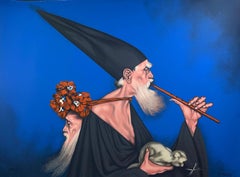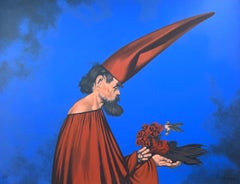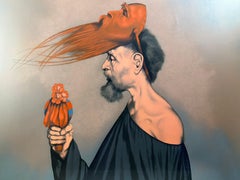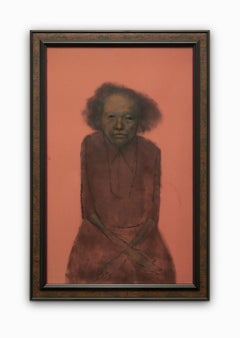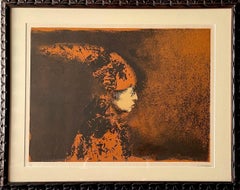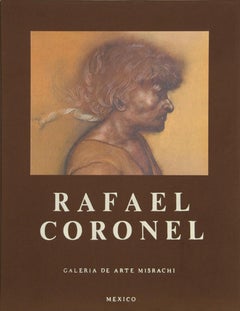Rafael Coronel Art
to
1
4
6
1
Overall Width
to
Overall Height
to
11
2
8
1
7
3
10
10
7
4
3
2
2
1
1
1
1
1
1
1
7
2
1
1
1
22
7,736
4,946
2,504
1,373
3
11
Artist: Rafael Coronel
Mono distraído (Distracted Monkey) (28/100)
By Rafael Coronel
Located in San Francisco, CA
Serigraph by Mexican painter Rafael Coronel. Edition 28 of 100. Certificate of authenticity included.
Category
Late 20th Century Contemporary Rafael Coronel Art
Materials
Screen
Colibrí (Hummingbird) (P/E)
By Rafael Coronel
Located in San Francisco, CA
Serigraph by Mexican painter Rafael Coronel. The artist made 100 signed and numbered editions. This is a signed Artist Proof edition (handwritten as "P/E" on the lower left corner wh...
Category
Late 20th Century Contemporary Rafael Coronel Art
Materials
Screen
Santiago (A/P)
By Rafael Coronel
Located in San Francisco, CA
Serigraph by Mexican painter Rafael Coronel. Edition of 100. Certificate of authenticity included.
Category
Late 20th Century Contemporary Rafael Coronel Art
Materials
Screen
Fantastic Rafael Coronel Mixed Media 1961
By Rafael Coronel
Located in Detroit, MI
"Untitled" is a dramatically placed individual who appears to be withdrawing into herself surrounded by a soft pinkish color. She has a sad look in her non-reflective eyes. This pain...
Category
Mid-20th Century Futurist Rafael Coronel Art
Materials
Mixed Media, Board, ABS
Niño Payaso, Original Stone Lithograph Mexican Child Clown Portrait, Rust, Black
By Rafael Coronel
Located in Union City, NJ
Niño Payaso is an original hand drawn stone lithograph by the Mexican artist Rafael Coronel. Niño Payaso was printed one color at a time on archival printmaking paper using traditional hand lithography techniques in Paris c.1973 from lithographic stones drawn by the artist.
Niño Payaso is a sensitive profile portrait depicting a young boy wearing an antique-style clown outfit whose image suggests a deeply dispirited child at a moment of gloom; a very strong impression printed in rust orange, light beige and black ink on buff colored paper.
Framed size - 24 x 30 in., dark brown Mexican wood frame...
Category
1970s Contemporary Rafael Coronel Art
Materials
Lithograph
Galeria de Arte Misrachi Portfolio, 20 Modern Lithographs by Rafael Coronel
By Rafael Coronel
Located in Long Island City, NY
Artist: Rafael Coronel (after), Mexican (1931 - )
Title: Galeria de Arte Misrachi
Year: 1978
Medium: Portfolio of 20 Offset Lithographs, each signed in the plate
Edition Size: 2000
P...
Category
1970s Post-Modern Rafael Coronel Art
Materials
Offset
Moro con clavel (Moor with Carnation) (A/P)
By Rafael Coronel
Located in San Francisco, CA
Serigraph by Mexican painter Rafael Coronel. Edition of 100. Certificate of authenticity included.
Category
Late 20th Century Contemporary Rafael Coronel Art
Materials
Screen
El hilo del escarabajo, The Beetle Thread (A/P)
By Rafael Coronel
Located in San Francisco, CA
Serigraph by Mexican painter Rafael Coronel. Edition of 100. Certificate of authenticity included.
Category
Late 20th Century Contemporary Rafael Coronel Art
Materials
Screen
Rafael Coronel, "Untitled, " Mixed Media on Painter's Board, Signed by Artist
By Rafael Coronel
Located in Los Angeles, CA
'Untitled' by Rafael Coronel, is a fabulous and stylistically distinct example of Coronel's work from the 1960s and 1970s in which his subjects are located at the surface of blank, ...
Category
Late 20th Century Expressionist Rafael Coronel Art
Materials
Mixed Media
Beatificación (Beatification) (A/P)
By Rafael Coronel
Located in San Francisco, CA
Serigraph by Mexican painter Rafael Coronel. Edition of 100. Certificate of authenticity included.
Category
Late 20th Century Contemporary Rafael Coronel Art
Materials
Screen
La ofrenda (The Offering) (5/100)
By Rafael Coronel
Located in San Francisco, CA
Serigraph by Mexican painter Rafael Coronel. Edition 5 of 100. Certificate of authenticity included.
Category
Late 20th Century Contemporary Rafael Coronel Art
Materials
Screen
Related Items
'Portrait of Future Man', German School
Located in London, GB
'Portrait of Future Man', oil on board, Berlin School, (circa 1960s). A thoroughly modern portrait clearly in the style of Italian Futurist, Fortunato Depero (1892-1960). Futurism co...
Category
1960s Futurist Rafael Coronel Art
Materials
Oil, Board
BALLET VISIONS (PLATE 2)
By Jane Bazinet
Located in Aventura, FL
Serigraph in colors on paper. Hand signed, titled and numbered by the artist. From the edition of 275. Sheet size 32 x 22 inches. Image size approx 29 x 19.5 inches.
Artwork is in excellent condition. Certificate of authenticity included. All reasonable offers will be considered.
Please note our gallery has more than 1 of this artwork in stock and the exact edition number you may receive may be different than pictured.
About the artist:
Jane Bazinet...
Category
1980s Contemporary Rafael Coronel Art
Materials
Lithograph, Paper
"Personaje" 1991 Signed Original Silkscreen & Watercolor Proof 16x12in Cubism
Located in Miami, FL
"Juan Sebastian Barbera (Mexico, 1964)
'Personaje', 1991
Silkscreen and Watercolor on paper Velin Arches 300 g.
15.8 x 11.9 in. (40 x 30 cm.)
ID...
Category
1990s Contemporary Rafael Coronel Art
Materials
Screen, Watercolor
The Talmudists Post Soviet Non Conformist Avant Garde Judaica Lithograph
By Alek Rapoport
Located in Surfside, FL
Dimensions w/Frame: 18.5 X 14.5
Alek Rapoport (November 24, 1933, Kharkiv, Ukraine SSR – February 4, 1997, San Francisco) was a Russian Nonconformist artist, art theorist and teacher.
Alek Rapoport spent his childhood in Kiev (Ukraine SSR). During Stalin's "purges" both his parents were arrested. His father was shot and his mother spent ten years in a Siberian labor camp. Rapoport lived with his aunt. At the beginning of World War II, he was evacuated to the city of Ufa (the Bashkir Autonomous Soviet Socialist Republic). A time of extreme loneliness, cold, hunger and deprivation, this period also marked the beginning of Rapoport's drawing studies.
After the war, Rapoport lived in Chernovtsy (Western Ukraine), a city with a certain European flair. At the local House of Folk Arts, he found his first art teacher, E.Sagaidachny (1886–1961), a former member of the nonconformist artist groups Union of the Youth (Soyuz Molodyozhi) and Donkey's Tail, popular during the 1910s–1920s. His other art teacher was I. Beklemisheva (1903–1988). Impressed by Rapoport's talent, she later (1950) organized his move to Leningrad, where he entered the famous V.Serov School of Art (the former School of the Imperial Society for the Promotion of Arts, OPKh, later the Tavricheskaya Art School).
His association with this school lasted eight years, first as a student, and then, from 1965 to 1968, as a teacher. With "Socialist realism" the only official style during this time, most of the art school's faculty had to conceal any prior involvement in non-conformist art movements. Ya.K.Shablovsky, V.M.Sudakov, A.A.Gromov introduced their students to Constructivism only through clandestine means.
(1959–1963) Rapoport studied stage design at the Leningrad Institute of Theater, Music and Cinema under the supervision of the famous artist and stage director N.P.Akimov. Akimov taught a unique course based on theories of Russian Suprematism and Constructivism, while encouraging his graduate students to apply their knowledge to every field of art design. Despite differences in personal artistic taste with Akimov, who was drawn to Vermeer and Dalí, Rapoport was influenced by Akimov's personality and liberalism, as well as the logical style of his art.
In 1963, Rapoport graduated from the institute. His highly acclaimed MFA work involved the stage and costume design for I.Babel's play Sunset. In preparation, he traveled to the southwest regions of the Soviet Union, where he accumulated many objects of Judaic iconography from former ghettos, disappearing synagogues and old cemeteries. He wandered Odessa in search of Babel's characters and the atmosphere of his books.
He organized a new liberal course in technical aesthetics, introducing his students to Lotman's theory of semiotics, the Modulor of Le Corbusier, the Bauhaus school, Russian Constructivism, Russian icons and contemporary Western art. As a result of his "radicalism," Rapoport was fired for "ideological conspiracy."
He sought to cultivate himself as Jewish artist. This became particularly noticeable after the Six-Day War, when the Israeli victory led intellectuals, including the Jewish intelligentsia, to feel a heightened interest in Jewish culture and its Biblical roots. Rapoport's works of this period include Three Figures, a series of images of Talmudic Scholars, and works dealing with anti-Semitism. In the 1970s Rapoport joined the non-conformist movement, which opposed the dogmas of "Socialist realism" in art, along with Soviet censorship. The movement sought to preserve the traditions of Russian iconography...
Category
1970s Post-Modern Rafael Coronel Art
Materials
Lithograph
Honor Thy Father and Thy Mother (The Fifth Commandment) Lithograph Signed/N
By Robert Kushner
Located in New York, NY
Robert Kushner
Honor Thy Father and Thy Mother (The Fifth Commandment), 1987
6 Color Lithograph on Dieu Donne handmade paper
24 × 18 inches
Pencil signed and numbered 6/84 in graphite on the front
Unframed with deckled edges
This five color lithograph on Dieu Donne hand made paper with deckled edges is pencil signed, dated and numbered from the limited edition of 84. This 1980s Robert Kushner print was created as part of the 1987 portfolio "The Ten Commandments", in which ten top Jewish American artists were each invited to choose an Old Testament commandment to interpret in contemporary lithographic form. The "Chosen" artists were, in order of Commandment: Kenny Scharf, Joseph Nechvatal, Gretchen Bender, April Gornik, Robert Kushner, Nancy Spero, Vito Acconci, Jane Dickson, Judy Rifka and Richard Bosman. This is the first time the print will have been removed from the original portfolio case. (shown). Lisa Liebmann, who wrote the introduction to the collection, observed: "...The image has, for most of us, replaced the word..." With respect to the present work, she writes, "There is a sweet smell of nostalgia to Robert Kushner's view of the FIFTH COMMANDMENT, to honor one's parents. Kushner's subtly ornate use of colors suffuses his subject with a filagreed texture of warmth. In this gentle icon, the traditional duo - all those Ozzies and Harriets in our hearts and on the airwaves -are frames as if by a bubble bath of affection."
ROBERT KUSHNER BIOGRAPHY
Since participating in the early years of the Pattern and Decoration Movement in the 1970s, Robert Kushner has continued to address controversial issues involving decoration. Kushner draws from a unique range of influences, including Islamic and European textiles, Henri Matisse, Georgia O’Keeffe, Charles Demuth, Pierre Bonnard, Tawaraya Sotatsu, Ito Jakuchu, Qi Baishi, and Wu...
Category
1980s Contemporary Rafael Coronel Art
Materials
Lithograph
Mai (Afterlife) after Sir Joshua Reynolds' Portrait of Mai (Omai)
By Elizabeth Peyton
Located in London, GB
Mai (Afterlife) after Sir Joshua Reynolds' Portrait of Mai (Omai), 2023
15-layer silkscreen on 410gsm Somerset tub-sized radiant white paper
19 9/10 × 14 4/5 in 50.5 × 37.7 cm
Editi...
Category
2010s Contemporary Rafael Coronel Art
Materials
Screen
Night: William Dunas Dance 1 (Pamela), Pop Art Print by Alex Katz
By Alex Katz
Located in Long Island City, NY
Artist: Alex Katz, American (1927 - )
Title: Night: William Dunas Dance 1 (Pamela)
Year: 1983
Medium: Lithograph on Arches, signed and numbered in pencil
Edition: 100, 42 AP
Size: 25...
Category
1980s Contemporary Rafael Coronel Art
Materials
Lithograph
Bust of a Seated Man (Jacques Dupin) - Lithograph by Alberto Giacometti - 1961
By Alberto Giacometti
Located in Roma, IT
Lithograph on vélin realized by Giacometti for Derrière le Miroir n. 127, in 1961.
Ref. lust 152; ADG (Alberto Giacometti's Database) 334
Very good condition.
Category
1960s Contemporary Rafael Coronel Art
Materials
Lithograph
H 14.57 in W 10.63 in D 0.4 in
Philippe Noyer Le Singe 1980 A Signed Limited Edition
By Philippe Henri Noyer
Located in Rochester Hills, MI
Artist Name: Philippe Noyer
Title: Le Singe:
Medium Type: Lithograph
Size-Width Size-Height: 35" x 25"
Signed Edition Size: signed in pencil and marked EA XVII/XXX
Unframed in...
Category
1980s Post-Modern Rafael Coronel Art
Materials
Lithograph
H 41 in W 27 in D 1 in
Art Critic
By Roy Lichtenstein
Located in Miami, FL
Hand signed rf Lichtenstein, numbered and dated '96 in pencil lower left. Printed by Noblet Serigraphie Inc., New York. Produced as a benefit for the Brooklyn Academy of Music (BAM) ...
Category
1990s Contemporary Rafael Coronel Art
Materials
Screen
The Rabbi 1977 Soviet Non Conformist Avant Garde Print
By Alek Rapoport
Located in Surfside, FL
Dimensions w/Frame: 25 3/4" x 20 3/4"
Alek Rapoport (November 24, 1933, Kharkiv, Ukraine SSR – February 4, 1997, San Francisco) was a Russian Nonconformist artist, art theorist and teacher.
Alek Rapoport spent his childhood in Kiev (Ukraine SSR). During Stalin's "purges" both his parents were arrested. His father was shot and his mother spent ten years in a Siberian labor camp. Rapoport lived with his aunt. At the beginning of World War II, he was evacuated to the city of Ufa (the Bashkir Autonomous Soviet Socialist Republic). A time of extreme loneliness, cold, hunger and deprivation, this period also marked the beginning of Rapoport's drawing studies.
After the war, Rapoport lived in Chernovtsy (Western Ukraine), a city with a certain European flair. At the local House of Folk Arts, he found his first art teacher, E.Sagaidachny (1886–1961), a former member of the nonconformist artist groups Union of the Youth (Soyuz Molodyozhi) and Donkey's Tail, popular during the 1910s–1920s. His other art teacher was I. Beklemisheva (1903–1988). Impressed by Rapoport's talent, she later (1950) organized his move to Leningrad, where he entered the famous V.Serov School of Art (the former School of the Imperial Society for the Promotion of Arts, OPKh, later the Tavricheskaya Art School).
His association with this school lasted eight years, first as a student, and then, from 1965 to 1968, as a teacher. With "Socialist realism" the only official style during this time, most of the art school's faculty had to conceal any prior involvement in non-conformist art movements. Ya.K.Shablovsky, V.M.Sudakov, A.A.Gromov introduced their students to Constructivism only through clandestine means.
(1959–1963) Rapoport studied stage design at the Leningrad Institute of Theater, Music and Cinema under the supervision of the famous artist and stage director N.P.Akimov. Akimov taught a unique course based on theories of Russian Suprematism and Constructivism, while encouraging his graduate students to apply their knowledge to every field of art design. Despite differences in personal artistic taste with Akimov, who was drawn to Vermeer and Dalí, Rapoport was influenced by Akimov's personality and liberalism, as well as the logical style of his art.
In 1963, Rapoport graduated from the institute. His highly acclaimed MFA work involved the stage and costume design for I.Babel's play Sunset. In preparation, he traveled to the southwest regions of the Soviet Union, where he accumulated many objects of Judaic iconography from former ghettos, disappearing synagogues and old cemeteries. He wandered Odessa in search of Babel's characters and the atmosphere of his books.
He organized a new liberal course in technical aesthetics, introducing his students to Lotman's theory of semiotics, the Modulor of Le Corbusier, the Bauhaus school, Russian Constructivism, Russian icons and contemporary Western art. As a result of his "radicalism," Rapoport was fired for "ideological conspiracy."
He sought to cultivate himself as Jewish artist. This became particularly noticeable after the Six-Day War, when the Israeli victory led intellectuals, including the Jewish intelligentsia, to feel a heightened interest in Jewish culture and its Biblical roots. Rapoport's works of this period include Three Figures, a series of images of Talmudic Scholars, and works dealing with anti-Semitism. In the 1970s Rapoport joined the non-conformist movement, which opposed the dogmas of "Socialist realism" in art, along with Soviet censorship. The movement sought to preserve the traditions of Russian iconography and the Constructivist/Suprematist style of the 1910s. Despite the authorities' persecutions of nonconformist artists (including arrests, forced evictions, terminations of employment, and various forms of routine hassling), they united in a group, "TEV – Fellowship of Experimental Exhibitions." TEV's exhibitions proved tremendously successful.
In the same period, Rapoport became one of the initiators of another anti-establishment group, ALEF (Union of Leningrad's Jewish Artists). In the United States this group was known as "Twelve from the Soviet Underground." Rapoport's involvement with this group increased tension with the authorities and attracted KGB scrutiny, including "friendly conversations," surveillance, detentions and house arrests. It became increasingly dangerous for him to live and work in the USSR. In October 1976, Rapoport with his wife and son were forced to leave Russia.
In Italy, Rapoport exhibited at the Venice Biennale, "La Nuova Arte Sovietica-Una prospettiva non-ufficiale" (1977), participated in television programs about nonconformist art in the Soviet Union, and created lithographic works continuing his theme of Jewish characters from Babel's play Sunset.
In 1977, Rapoport's family was granted U.S. immigration status and settled in San Francisco. a significant event in Rapoport's life occurred in his meeting with San Francisco gallery owner Michael Dunev, who became his friend and representative, organizing all his exhibitions until the artist's death.
Toward the end of the 1980s and beginning of the 1990s, Rapoport completed his most ambitious works on the theme of the Old Testament prophets: Samson Destroying the House of the Philistines (1989), Lamentation and Mourning and Woe (1990), the four paintings Angel and Prophets (1990–1991) and Three Deeds of Moses (1992).
In 1992, the artist's friends in St. Petersburg organized the first exhibition of his works there since his departure into exile, with works patiently gathered from collectors and art museums. This exhibition, held in the City Museum of St. Petersburg and accompanied by headlines such as "A St. Petersburg artist returns to his town," was followed by much larger ones in 1993 (St. Petersburg and Moscow), organized in collaboration with Michael Dunev Gallery under the name California Branches – Russian Roots.
He Exhibited in "Soviet Artists, Jewish Themes...
Category
1970s Post-Modern Rafael Coronel Art
Materials
Lithograph
Chess Game (15/100)
By Gustavo Montoya
Located in San Francisco, CA
A Mahatma Gandhi-like person is seating over a chess game and the reflection is seen on the individual’s reading glasses. This color lithograph by Mexican artist Gustavo Montoya was ...
Category
1980s Contemporary Rafael Coronel Art
Materials
Lithograph
Rafael Coronel art for sale on 1stDibs.
Find a wide variety of authentic Rafael Coronel art available for sale on 1stDibs. If you’re browsing the collection of art to introduce a pop of color in a neutral corner of your living room or bedroom, you can find work that includes elements of purple and other colors. You can also browse by medium to find art by Rafael Coronel in mixed media, abs, board and more. Much of the original work by this artist or collective was created during the 20th century and is mostly associated with the Expressionist style. Not every interior allows for large Rafael Coronel art, so small editions measuring 19 inches across are available. Customers who are interested in this artist might also find the work of Francisco Corzas, Juan Soriano, and Fortunato Depero. Rafael Coronel art prices can differ depending upon medium, time period and other attributes. On 1stDibs, the price for these items starts at $1,600 and tops out at $24,000, while the average work can sell for $10,400.
